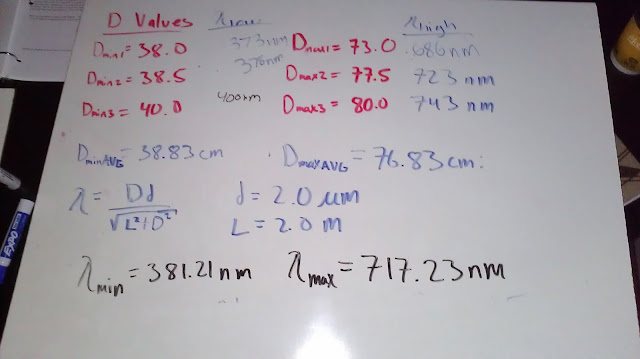Introduction:
This experiment will investigate the spectrum of colors associated with white light and hydrogen tubes. An incandescent light bulb will simulate our white light source. White light is a combination of many wavelength and emits the whole range of visible light. We will observe the maximum and minimum wavelength visible. The hydrogen gas tube contains many single hydrogen atoms. We know electrons in hydrogen shells will transition given a high potential. Here we use 5000 volts across the tube. Photons of certain wavelengths will be absorbed. We will investigate which wavelength should theoretically be absorbed and take measurements to confirm using the setup to be described. A grating will separate the spectrum for us.
Steps:
By similar triangles of the grating and eyeball side-view we obtain a relationship between the apparatus distances and the wavelength of light observed:
 |
| Actual setup of the apparatus. |
 |
| Observed spectrum from incandescent light bulb. We observe violet to be the closest to the light bulb and red the furthest away. |
 |
| Observed D values averaged then wavelength calculated. |
 |
| Uncertainty associated with the above measurements. As seen in many figures, calculators were essential to this experiments success. |
 |
| Linear fit to check agreement with calculated results. |
The shortest wavelength we observed in the visible spectrum was 381.21 nm.
The longest wavelength observed was 717.23 nm.
Using a hydrogen gas tube:
 |
| Calculations for theoretical values of wavelengths to be observed on hydrogen gas tube. Where R is the Rydberg constant. |
 |
| A hydrogen gas tube spectrum observation |
 |
| Measurements and calculations made on successive trials for our hydrogen tube. Uncertainty is included. |
Conclusion:
The error associated with the hydrogen gas tube can calculated as:
These results are pleasingly precise as they were all within uncertainty.

No comments:
Post a Comment